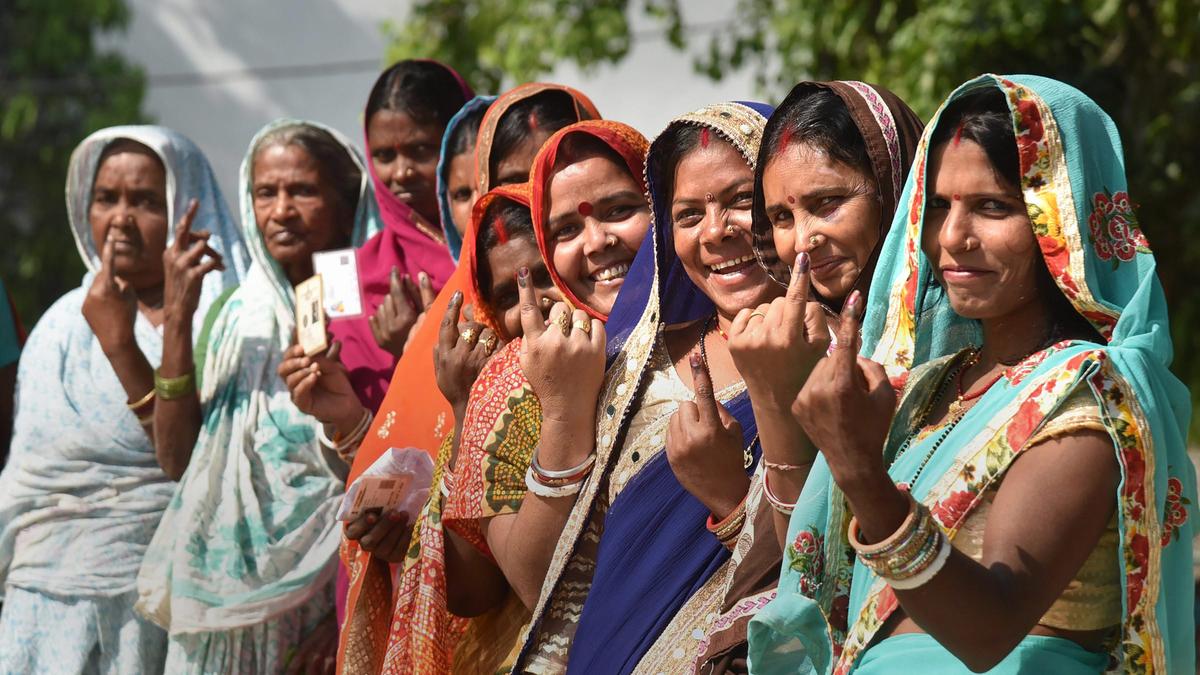Voters show their finger marked with indelible ink after casting vote at a polling station, during the fifth phase of Lok Sabha elections in Vaishali, Bihar
| Photo Credit: –
In the 2024 general elections, Bihar was one of the few States where a higher percentage of women voted compared to men, even though there were fewer women than men registered on the electoral rolls. The plausible explanation for this was that a high number of men had migrated from the State to other parts of the country and were unable to travel back to their respective constituencies.
One of the ostensible reasons for the Election Commission of India to conduct its Special Intensive Revision exercise — done within 40 days between June 25 and August 1 — was to exclude voters who were not ordinarily resident in Bihar, including migrants working outside the State. Given that the turnout of men was lower than the turnout of women (by several percentage points in some seats) in the election, it was expected that the share of male electors would be pruned, leading to a higher gender ratio from the 907 female voters for every 1,000 male voters registered in the 2024 general elections.
However, the final SIR rolls show the opposite trend. The gender ratio has come down to 892, one point lower than what it was in the draft electoral rolls in August. This suggests that there were barely any re-inclusions of women who had been excluded from the draft rolls. The fall in the gender ratio since the Lok Sabha elections in parliamentary constituencies also shows a moderate correlation (0.45) with the increase in female turnout relative to men.
The chart below illustrates this relationship: in constituencies where the female turnout was higher than the male voter turnout, the exclusion of women from the electoral rolls was higher in the final rolls. It shows the ratio of female to male electors against the ratio of female to male voter turnout in the 2024 Lok Sabha elections.
The chart below shows the gender ratio of voters in the 2024 Lok Sabha elections in the horizontal axis and the decline in gender ratio since the elections to the final SIR roll.
In parliamentary constituencies such as Gopalganj, which registered 1,218 women voting for every 1,000 men who voted, the reduction in the gender ratio from the 2024 general elections to the final SIR roll was 8.38% (967 to 886). The corresponding numbers for Kishanganj were 1,066 women and 7% respectively.
These numbers suggest that a significant number of eligible female electors could have been left out in the final SIR rolls. In previous Data Points, we had found that the exclusions were higher in the 18-29 age category and particularly for the reason, ‘permanently shifted’. The ECI said in the Supreme Court that women’s names would have been excluded as they had migrated to other States after marriage. Yet, our data stories had shown that more men migrated for work than women who migrated for marriage, according to the Census and later surveys.
Ground reports from Gopalganj and Kishanganj by The Hindu revealed that many women whose names were taken off had not gone far: some had moved to neighbouring villages in the same seat and some were registered in the rolls in booths which represented their residence after marriage.
Yet, the large-scale reduction in the gender ratio across the entire State, except for a few seats suggests that not all women who had married and migrated to other parts of the State would have re-registered themselves in the rolls. When this question was put forth to the Chief Election Commissioner on October 5 in Patna, he put the onus on political parties to include names that had been left out and said such revisions could continue till 10 days before the deadline for filing nominations.
The map below shows the seat-wise absolute change in gender ratio between the January and September 2025 rolls
The SIR exercise whittled down the electoral roll from 7.89 crore in January 2025 to 7.42 crore in September 2025, with the net exclusion of 47 lakh voters across Bihar. The map below shows the seat-wise percentage change in electors between the January and September 2025 rolls. The highest deletions have occurred in seats at or near the State’s border.
Source: Election Commission of India
Published – October 15, 2025 08:00 am IST
